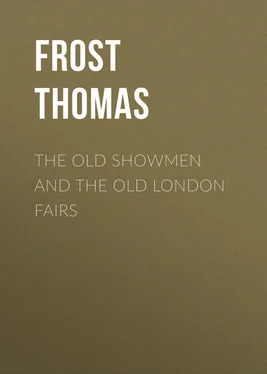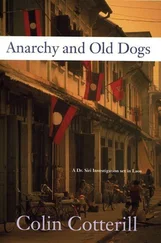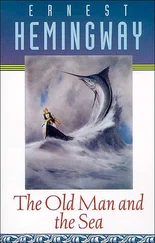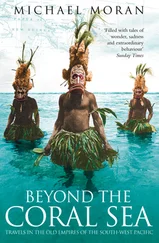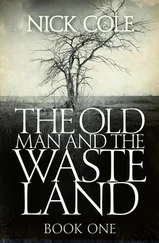Thomas Frost - The Old Showmen and the Old London Fairs
Здесь есть возможность читать онлайн «Thomas Frost - The Old Showmen and the Old London Fairs» — ознакомительный отрывок электронной книги совершенно бесплатно, а после прочтения отрывка купить полную версию. В некоторых случаях можно слушать аудио, скачать через торрент в формате fb2 и присутствует краткое содержание. Жанр: foreign_antique, foreign_prose, на английском языке. Описание произведения, (предисловие) а так же отзывы посетителей доступны на портале библиотеки ЛибКат.
- Название:The Old Showmen and the Old London Fairs
- Автор:
- Жанр:
- Год:неизвестен
- ISBN:нет данных
- Рейтинг книги:4 / 5. Голосов: 1
-
Избранное:Добавить в избранное
- Отзывы:
-
Ваша оценка:
- 80
- 1
- 2
- 3
- 4
- 5
The Old Showmen and the Old London Fairs: краткое содержание, описание и аннотация
Предлагаем к чтению аннотацию, описание, краткое содержание или предисловие (зависит от того, что написал сам автор книги «The Old Showmen and the Old London Fairs»). Если вы не нашли необходимую информацию о книге — напишите в комментариях, мы постараемся отыскать её.
The Old Showmen and the Old London Fairs — читать онлайн ознакомительный отрывок
Ниже представлен текст книги, разбитый по страницам. Система сохранения места последней прочитанной страницы, позволяет с удобством читать онлайн бесплатно книгу «The Old Showmen and the Old London Fairs», без необходимости каждый раз заново искать на чём Вы остановились. Поставьте закладку, и сможете в любой момент перейти на страницу, на которой закончили чтение.
Интервал:
Закладка:
Glee-men was a term which included dancers, posturers, jugglers, tumblers, and exhibitors of trained performing monkeys and quadrupeds; and, the masculine including the feminine in this case, many of these performers were women and girls. The illuminations which have been referred to, and which constitute our chief authority as to the amusements of the fairs during the middle ages, introduce us to female posturers and tumblers, in the act of performing the various feats which have been the stock in trade of the acrobatic profession down to the present day. The jugglers exhibited the same feats with balls and knives as their representatives of the nineteenth century; what is professionally designated “the shower,” in which the balls succeed each other rapidly, while describing a semi-circle from right to left, is shown in one of the Harleian illuminations.
Balancing feats were also exhibited, and in one of these curious illustrations of the sights which delighted our fair-going ancestors, the balancing of a cart-wheel is represented – a trick which might have been witnessed not many years ago in the streets of London, the performer being an elderly negro, said to have been the father of the well-known rope-dancer, George Christoff, who represented the Pompeian performer on the corde elastique , when Mr. Oxenford’s version of The Last Days of Pompeii was produced at the Queen’s Theatre.
Performing monkeys, bears, and horses appear in many of the mediæval illuminations, and were probably as popular agents of public amusement in the earliest years of Bartlemy fair as they can be shown, from other authorities, to have been in the sixteenth century. That monkeys were imported rather numerously for the amusement of the public, may be inferred from the fact of some Chancellor of the Exchequer of the middle ages having subjected them to an import duty. Their agility was displayed chiefly in vaulting over a chain or cord. Bears were taught to feign death, and to walk erect after their leader, who played some musical instrument. Horses were also taught to walk on their hind legs, and one drawing in the Harleian collection shows a horse in this attitude, engaged in a mimic fight with a man armed with sword and buckler.
All these performances seem to have been continued, by successive generations of performers, down to the time of Elizabeth. Reginald Scot, writing in 1584, gives a lengthy enumeration of the tricks of the jugglers who frequented the fairs of the latter part of the sixteenth century. Among them are most of the common tricks of the present day, and not the least remarkable is the decapitation feat, which many of my readers have probably seen performed by the famous wizards of modern times at the Egyptian Hall. Three hundred years ago, it was called the decollation of St. John the Baptist, and was performed upon a table, upon which stood a dish to receive the head. The table, the dish, and the knife used in the apparent decapitation were all contrived for the purpose, the table having two holes in it, one to enable the assistant who submitted to the operation to conceal his head, the other, corresponding to a hole in the dish, to receive the head of another confederate, who was concealed beneath the table, in a sitting position; while the knife had a semi-circular opening in the blade to fit the neck. Another knife, of the ordinary kind, was shown to the spectators, who were prevented by a sleight of hand trick from observing the substitution for it of the knife used in the trick. The engraving in Malcolm’s work shows the man to be operated upon lying upon the table, apparently headless, while the head of the other assistant appears in the dish.
That lusus naturæ , and other natural curiosities, had begun to be exhibited by showmen in the reign of Elizabeth, may be inferred from the allusions to such exhibitions in The Tempest , when Caliban is discovered, and the mariners speculate upon his place in the scale of animal being. It seems also that the practice of displaying in front of the shows large pictures of the wonderful feats, or curious natural objects, to be seen within, prevailed in the sixteenth century, and probably long before; for it is distinctly alluded to in a passage in Jonson’s play of The Alchymist , in which the master of the servant who has filled the house with searchers for the philosopher’s stone, says,
“What should my knave advance
To draw this company? He hung out no banners
Of a strange calf with five legs to be seen,
Or a huge lobster with six claws.”
Some further glimpses of the Bartlemy fair shows of the Elizabethan period are afforded in the induction or prologue to another play of Jonson’s, namely, the comedy of Bartholomew Fair , acted in 1614. “He,” says the dramatist, speaking of himself, “has ne’er a sword and buckler-man in his fair; nor a juggler with a well-educated ape to come over the chain for the King of England, and back again for the Prince, and sit still on his haunches for the Pope and the King of Spain.” The sword and buckler-man probably means a performer who took part in such a mimic combat of man and horse, as is represented in the illumination which has been referred to. The monkey whose Protestant proclivities are noted in the latter part of the passage is mentioned in a poem of Davenant’s, presently to be quoted.
We cannot suppose absent from the metropolitan fairs the celebrated performing horse, Morocco, and his instructor, of whom Sir Walter Raleigh says, “If Banks had lived in older times, he would have shamed all the enchanters in the world; for whosoever was most famous among them could never master or instruct any beast as he did.” That Shakspeare witnessed the performances of Morocco, which combined arithmetical calculations with saltatory exercises, is shown by the allusion in Love’s Labour Lost , when Moth puzzles Armado with arithmetical questions, and says, “The dancing horse will tell you.” Sir Kenelm Digby states that the animal “would restore a glove to the due owner after the master had whispered the man’s name in his ear; and would tell the just number of pence in any piece of silver coin newly showed him by his master.”
Banks quitted England for the Continent with his horse in 1608, and De Melleray, who witnessed the performance of the animal in the Rue St. Jacques, in Paris, says that Morocco could not only tell the number of francs in a crown, but knew that the crown was depreciated at that time, and knew the exact amount of the depreciation. From Paris, Banks travelled with his learned horse to Orleans, where the fame which they had acquired brought him under the imputation of being a sorcerer, and he had a narrow escape of being burned at a stake in that character. Bishop Morton says that he cleared himself by commanding his horse to “seek out one in the press of the people who had a crucifix on his hat; which done, he bade him kneel down unto it, and not this only, but also to rise up again, and to kiss it. ‘And now, gentlemen,’ (quoth he), ‘I think my horse hath acquitted both me and himself;’ and so his adversaries rested satisfied; conceiving (as it might seem) that the devil had no power to come near the cross.”
We next hear of Banks and his horse at Frankfort-on-the-Maine, where Bishop Morton saw them, and heard from the former the story of his narrow escape at Orleans. Their further wanderings cannot be traced; and, though it has been inferred, from a passage in a burlesque poem by Jonson, that Banks was burned as a sorcerer, the grounds which the poet had for assigning such a dreadful end for the famous horse-charmer are unknown, and may have been no more than an imperfect recollection of what he had heard of the Orleans story.
A hare which played the tabor is alluded to by Jonson in the comedy before mentioned; and this performance also was not unknown to earlier times, one of the illuminations copied by Strutt showing it to have been exhibited in the fifteenth century. When Jonson wrote his comedy, the amusing classes, encouraged by popular favour, were raising their heads again, after the sore discouragement of the Vagrancy Act of Elizabeth’s reign, which scheduled jugglers and minstrels with strolling thieves, gipsy fortune-tellers, and itinerant beggars. Elizabeth’s tastes seem to have inclined more to bull-baiting and bear-baiting than to dancing and minstrelsy, juggling and tumbling; and, besides this, there was a broad line drawn in those days, and even down to the reign of George III., as will be hereafter noticed, between the upper ten thousand and the masses, as to the amusements which might or ought to be permitted to the former and denied to the latter.
Читать дальшеИнтервал:
Закладка:
Похожие книги на «The Old Showmen and the Old London Fairs»
Представляем Вашему вниманию похожие книги на «The Old Showmen and the Old London Fairs» списком для выбора. Мы отобрали схожую по названию и смыслу литературу в надежде предоставить читателям больше вариантов отыскать новые, интересные, ещё непрочитанные произведения.
Обсуждение, отзывы о книге «The Old Showmen and the Old London Fairs» и просто собственные мнения читателей. Оставьте ваши комментарии, напишите, что Вы думаете о произведении, его смысле или главных героях. Укажите что конкретно понравилось, а что нет, и почему Вы так считаете.
